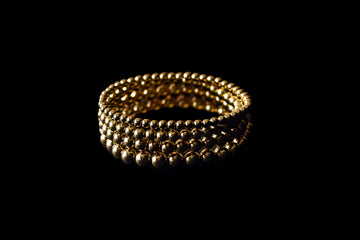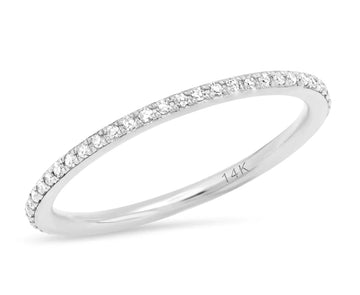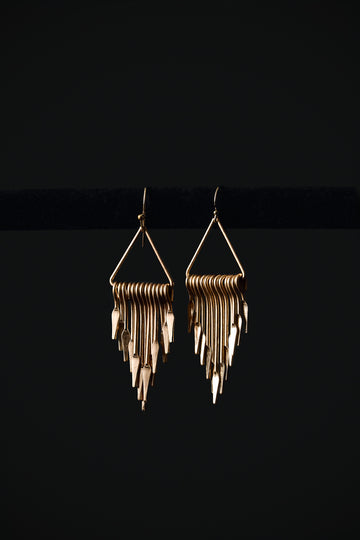Diamond & Gold Guide
Discover the Materials Behind the Jewelry Creations of Shelley Moon Designs

Ethically Sourced
We are committed to ethical sourcing and quality craftsmanship in every piece of jewelry we offer. Our partnerships with vendors and artisans are built on strict ethical standards and a deep understanding of the supply chain. Our gold is responsibly sourced from Fairmined Certified Mining Organizations, regulated and certified by the Responsible Jewellery Council (RJC), and subjected to rigorous third-party audits for ongoing compliance. Conflict-free stones undergo the Kimberly Process (KP) for additional assurance. The majority of our stones are meticulously cut and polished in downtown Los Angeles and Austin, ensuring superior quality control and supporting fair compensation and safe working conditions for our skilled makers. Our fine jewelry collection features 14k yellow and white gold, while our sustainable collection utilizes 100% sterling silver as the base metal, with a layer of 2.5 - 3 microns of yellow gold. Additionally, our gold-filled collection is crafted with either 14k or 18k yellow gold, depending on the collection and style, reflecting our commitment to sustainability and quality.
Varieties of Gold Jewelry



Varieties of Gold Jewelry

Yellow Gold
Yellow gold represents the pure, inherent color of gold. Often augmented with sterling silver, copper, and zinc for enhanced resilience, it retains its timeless allure.

White Gold
Derived from yellow gold through alloying with nickel, palladium, and zinc, white gold presents a lustrous, silver-white appearance, typically achieved through rhodium plating.

Rose Gold
Also known as pink gold, this variant is the product of blending pure gold with copper alloys, resulting in a distinctive rosy tint while fortifying the metal's structure.
Gold Karats
Understanding gold karats entails comprehending its purity fraction.
A karat, constituting 1/24th part of the whole, gauges the gold alloy's purity.
Lower karat levels indicate higher durability but lower gold content.
14 Karat Gold
Comprising 58.3% gold and 41.7% alloys, 14k gold offers a blend of durability and elegance, making it a favored choice for everyday wear.welcome customers to your store.
18 Karat Gold
With a higher gold content of 75%, 18k gold boasts superior quality, albeit with a slightly reduced durability compared to lower karat options.
24 Karat Gold
At 24 karats, gold is entirely pure, devoid of any added alloys. While exquisite, its softness renders it unsuitable for regular wear.
Types of Gold Jewelry

Gold Plated
Featuring a base metal coated with a thin layer of gold (less than 0.05% gold content), gold-plated jewelry offers an economical option but may suffer from fading or tarnishing over time.

Gold Vermeil
Characterized by a sterling silver base coated with a thick layer of gold plating, gold vermeil jewelry showcases enhanced quality and longevity. Distinguished by its electroplating process, it boasts a substantial gold layer for lasting brilliance

Solid Gold
As the epitome of luxury, solid gold jewelry comprises pure gold without any base metal, available in various karats to suit different preferences and budgets.
Lab Grown Diamond Guide
We're proud to offer a stunning selection of lab-grown diamonds that combine ethical sourcing with timeless beauty. Dive into the world of lab-grown diamonds and explore why they're becoming the preferred choice for conscious consumers worldwide.

What Are Lab-Grown Diamonds?
Lab-grown diamonds, also referred to as synthetic or cultured diamonds, are crafted in controlled laboratory settings instead of being mined from the Earth. While their origin may be different, lab-grown diamonds share the same chemical and physical properties as natural diamonds, making them truly authentic gems. Click below to read more.

A Brief History
The journey of lab-grown diamonds traces back to 1954 when scientists pioneered their creation through high-pressure, high-temperature (HPHT) methods. Over the decades, advancements in technology and manufacturing processes have led to the widespread availability of high-quality lab-grown diamonds, marking a significant shift in the diamond industry.

Quality and Value
Contrary to common misconceptions, lab-grown diamonds boast exceptional quality and durability. With proper certification and traceability, these diamonds hold significant value and are increasingly recognized in the jewelry market. Furthermore, lab-grown diamonds often come at a more accessible price point, allowing you to indulge in luxury without compromise.

